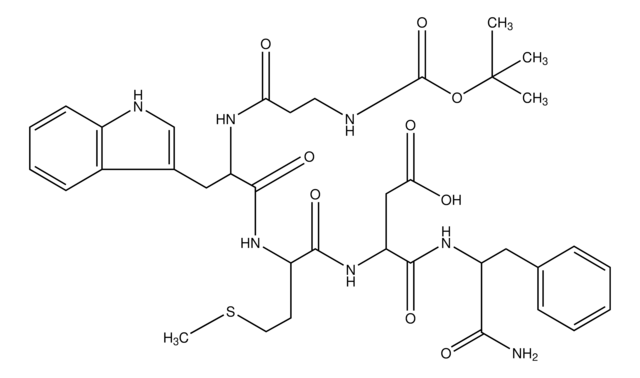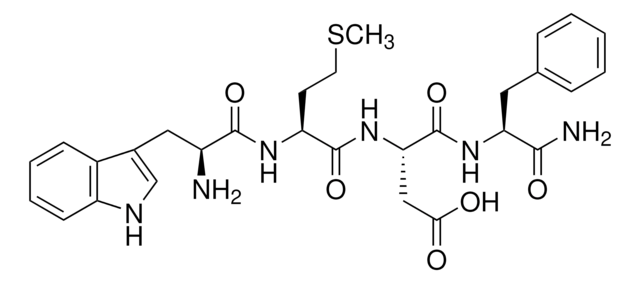Kluczowe dokumenty
B1636
Pentagastrin
≥95% (HPLC), powder, CCK2 receptor agonist
Synonim(y):
Peptavlon, Petogasrin, N-t-Boc-β-Ala-Trp-Met-Asp-Phe amide
About This Item
Polecane produkty
Nazwa produktu
Pentagastrin, ≥95% (HPLC), powder
Poziom jakości
Próba
≥95% (HPLC)
Formularz
powder
warunki przechowywania
(Keep container tightly closed in a dry and well-ventilated place.)
kolor
white to off-white
rozpuszczalność
DMF: 20 mg/mL, clear, colorless to faint yellow or tan
temp. przechowywania
−20°C
ciąg SMILES
CSCCC(NC(=O)C(Cc1c[nH]c2ccccc12)NC(=O)CCNC(=O)OC(C)(C)C)C(=O)NC(CC(O)=O)C(=O)NC(Cc3ccccc3)C(N)=O
InChI
1S/C37H49N7O9S/c1-37(2,3)53-36(52)39-16-14-30(45)41-28(19-23-21-40-25-13-9-8-12-24(23)25)34(50)42-26(15-17-54-4)33(49)44-29(20-31(46)47)35(51)43-27(32(38)48)18-22-10-6-5-7-11-22/h5-13,21,26-29,40H,14-20H2,1-4H3,(H2,38,48)(H,39,52)(H,41,45)(H,42,50)(H,43,51)(H,44,49)(H,46,47)
Klucz InChI
NEYNJQRKHLUJRU-UHFFFAOYSA-N
informacje o genach
mouse ... Cckbr(12426)
rat ... Cckar(24889) , Cckbr(25706)
Szukasz podobnych produktów? Odwiedź Przewodnik dotyczący porównywania produktów
Amino Acid Sequence
Opis ogólny
Zastosowanie
Działania biochem./fizjol.
Inhibitor
Kod klasy składowania
11 - Combustible Solids
Klasa zagrożenia wodnego (WGK)
WGK 3
Temperatura zapłonu (°F)
Not applicable
Temperatura zapłonu (°C)
Not applicable
Wybierz jedną z najnowszych wersji:
Masz już ten produkt?
Dokumenty związane z niedawno zakupionymi produktami zostały zamieszczone w Bibliotece dokumentów.
Nasz zespół naukowców ma doświadczenie we wszystkich obszarach badań, w tym w naukach przyrodniczych, materiałoznawstwie, syntezie chemicznej, chromatografii, analityce i wielu innych dziedzinach.
Skontaktuj się z zespołem ds. pomocy technicznej







